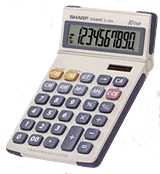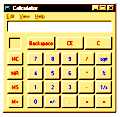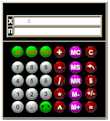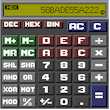 Electronic calculators. Since its beginnings, early in
the 1970’s, the market of pocket calculators has been very competitive.
At the end of the calculator wars, basically two types of
calculators have survived: Specialized business or scientific calculators made by
large companies such as Casio, Texas Instruments Sharp, and Hewlett Packard, and regular
four-function calculators made by a very wide range of companies. In this
second category, the competition is not based in functionality since all of them do
exactly the same thing, but instead it is based on appearance such as display size,
colors, shape, device texture and materials. I personally believe that it is in this
category where there is a lot of room for the usage of the 13-key design. A change
in the keyboard design, in addition of improving its usefulness by making it easier to
enter numbers, could tap into the “novelty” factor of the market (users
attracted to something new that has never been seen before.)
Electronic calculators. Since its beginnings, early in
the 1970’s, the market of pocket calculators has been very competitive.
At the end of the calculator wars, basically two types of
calculators have survived: Specialized business or scientific calculators made by
large companies such as Casio, Texas Instruments Sharp, and Hewlett Packard, and regular
four-function calculators made by a very wide range of companies. In this
second category, the competition is not based in functionality since all of them do
exactly the same thing, but instead it is based on appearance such as display size,
colors, shape, device texture and materials. I personally believe that it is in this
category where there is a lot of room for the usage of the 13-key design. A change
in the keyboard design, in addition of improving its usefulness by making it easier to
enter numbers, could tap into the “novelty” factor of the market (users
attracted to something new that has never been seen before.)
 PC Software
Calculators. A variation of the HEXACALC calculator written by the famous Windows
programmer and author Charles Petzold has been included by Microsoft as a Windows
accessory since the introduction of Windows 95. The use of a mouse to click on the keys of
a software calculator is highly inconvenient, especially when the number of digits is
relatively large (which is usually the case when you have to resort to the use of a
calculator). This is another area where the reduction in the number of keystrokes provided
by a 13-key design can be particularly useful. Currently, I'm in the process of writing a
Windows calculator in Visual C++ that will have this functionality (plus other ideas I
have about the design of a software calculator).
PC Software
Calculators. A variation of the HEXACALC calculator written by the famous Windows
programmer and author Charles Petzold has been included by Microsoft as a Windows
accessory since the introduction of Windows 95. The use of a mouse to click on the keys of
a software calculator is highly inconvenient, especially when the number of digits is
relatively large (which is usually the case when you have to resort to the use of a
calculator). This is another area where the reduction in the number of keystrokes provided
by a 13-key design can be particularly useful. Currently, I'm in the process of writing a
Windows calculator in Visual C++ that will have this functionality (plus other ideas I
have about the design of a software calculator).
 On-line Internet Calculators. This Web site provides several examples of On-line calculators. I have written all
of them in Java Script so that the source code could be easily reviewed and accessible,
however, they can be implemented in other languages such as Java and Active-X. There is no
license fee required for the usage of this Java Script code if the web site has no
commercial objectives. Just send me a note advising that you are using the code or the
algorithms.
On-line Internet Calculators. This Web site provides several examples of On-line calculators. I have written all
of them in Java Script so that the source code could be easily reviewed and accessible,
however, they can be implemented in other languages such as Java and Active-X. There is no
license fee required for the usage of this Java Script code if the web site has no
commercial objectives. Just send me a note advising that you are using the code or the
algorithms.
 Hand-held Computing Devices. The
success of Palm Computing (whose income surpassed in
1999 the one of its parent company 3Com) shows the importance of these type of devices.
All of them include some kind of software calculator. As with the PC software calculators,
the algorithms provided in the X-number patent could enhance its functionality.
Hand-held Computing Devices. The
success of Palm Computing (whose income surpassed in
1999 the one of its parent company 3Com) shows the importance of these type of devices.
All of them include some kind of software calculator. As with the PC software calculators,
the algorithms provided in the X-number patent could enhance its functionality.
Toy calculators. I've had the chance to show
how to use the extended keys to enter numbers to children under the age of seven by using
the calculator posted in my Web site. All were very exited when discovered how easy it was
for them to enter large numbers that before they would even hardly know how to pronounce.  Since then, I've
been putting attention to toy calculators in the market, and found that there are very few
of them. So far, the ones I found were just regular calculators made with colorful cases
and packed as "toys." I believe that a toy calculator should be designed with
some special functionality, which, in addition to using a 13-key very colorful keyboard,
should include some kind of numerical game (like guess-and-enter-the-answer and return a
right or wrong random sound) that would make its use enjoyable and educational for
children.
Since then, I've
been putting attention to toy calculators in the market, and found that there are very few
of them. So far, the ones I found were just regular calculators made with colorful cases
and packed as "toys." I believe that a toy calculator should be designed with
some special functionality, which, in addition to using a 13-key very colorful keyboard,
should include some kind of numerical game (like guess-and-enter-the-answer and return a
right or wrong random sound) that would make its use enjoyable and educational for
children.
PC Keyboards. If the usage of the structure
keys becomes widely accepted, then, it will be the time to add these keys to the numerical
keypads included in standard computer keyboards, the signals sent by the structure keys
will then be processed by the X-Number algorithms to handle the processing of numerical
data-entry operations.
Of course, the applications described above are just some
examples of the possible application of this data-entry method. In general, this
method can be implemented in any device or application requiring intensive numerical
data-entry operations.
If you are interested in obtaining a license to use this
patent in your products or applications, please contact:
James Redin
312 16th Place
Manhattan Beach, CA 90266
(310) 545-8092
In Japan:
Katsunori.Kadokura
3-25-11-1003 Koyama Shinagawa
Tokyo Japan